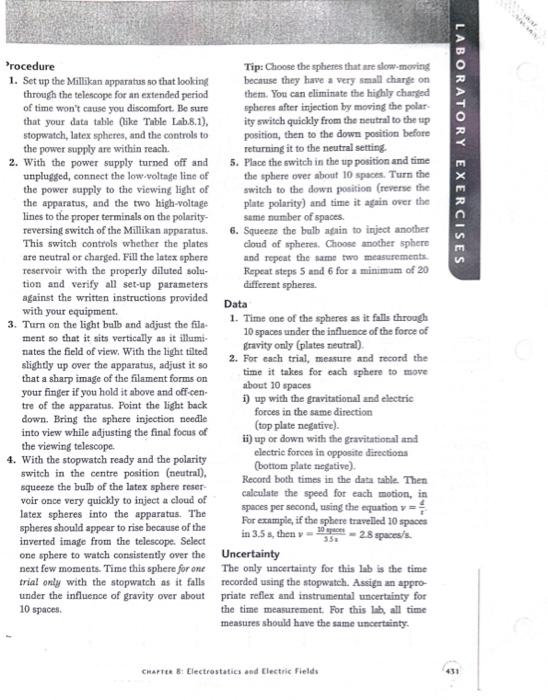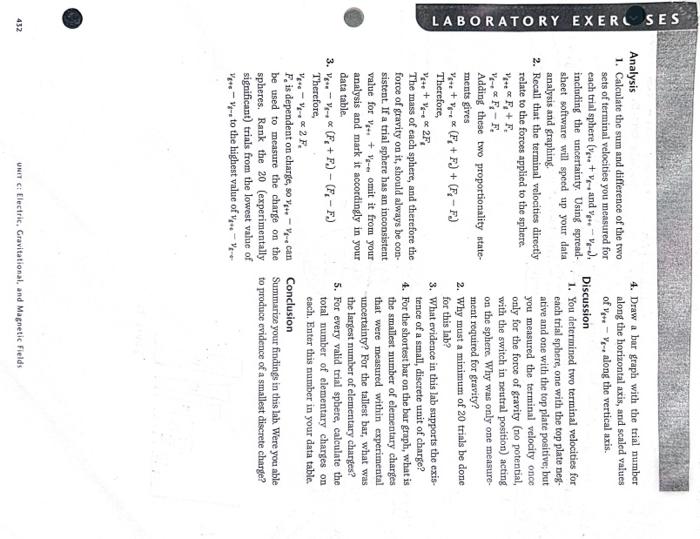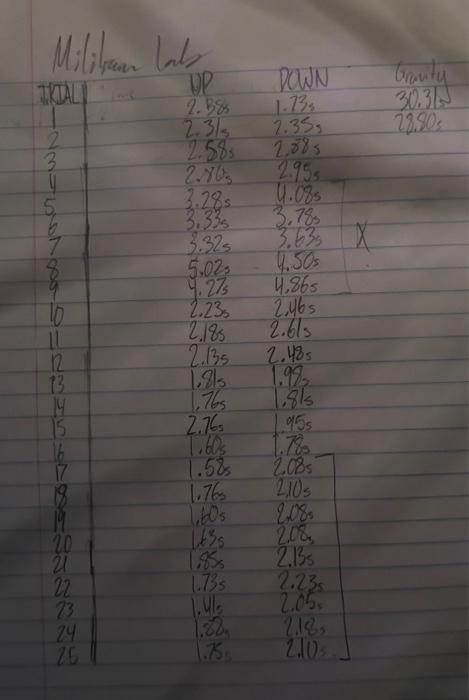Introduction In this lab, we will study small, discrete units of charge and statistically analyze the number of elementary charges on small latex spleres. We will assume that small latex spheres reach terminal velocity quickly when moving through a fluid such as air, and that the terminal velocity of each sphere is directly proportional to the total force acting on the sphere. Figure Lab. 8.1 shows the three different force situations that each sphere will experience. Figlab.8.1 Purpose To measure the smallest unit of electrical charge and to compare this experimental value with the one accepted by the scientific community Equipment A Millikan apparatus that uses latex spheres (available from most scientific mupply companies) (Figure Lab.8.2) Supply of latex spheres of known diameter High-voltage reversible power supply Stopwatch Safety Consideration This apparatus uses a high-voltago power supply (about 200 V). Be sure that the power supply is unpluffed and in the "off" position before consecting the wires of the apparatus to it Working with the power supply turned on could cause sparkins. unat ex Clectric, Cranitational, and Magnetic Fields 'rocedure 1. Set up the Millikan apparatus so that looking through the telescope for an extended period of time won't cause you discomfort. Be sure that your data table (iike Table Lab.8.1), stopwatch, latex spheres, and the controls to the power supply are within reach. 2. With the power supply turned off and unpluefed, connect the low voltage line of the power supply to the viewing light of the apparatus, and the two high-voltage lines to the proper terminals on the polarityreversing switch of the Millikan apparatus. This switch controls whether the plates are neutral or charged. Fill the latex sphere reservoir with the properly diluted solution and verify all set-up parameters against the written instructions provided with your equipment. 3. Turn on the light balb and adjust the filament so that it sits vertically as it illuminates the field of view. With the light tilted slightly up over the apparatus, adjust it so that a sharp image of the filament forms on your finger if you hold it above and off-centre of the apparatus. Point the light back down. Bring the sphere injection needle into view while adjusting the final focus of the viewing telescope. 4. With the stopwatch ready and the polarity switch in the centre position (neutral), squeeze the bulb of the latex sphere reservoir once very quickly to inject a cloud of latex spheres into the apparatus. The spheres should appear to rise because of the inverted image from the telescope. Select one sphere to wateh consistently over the next few moments. Time this sphere for one trial only with the stopwatch as it falls under the influence of gravity over about 10 spaces. Tip: Choose the spheres that are slow-moving because they have a very small charge on them. You can eliminate the highly charged epheres after injection by moving the polarity switch quickly from the neutral to the up position, then to the down position before returning it to the neutral setting. 5. Place the switch in the up position and time the sphere over about 10 spaces. Turn the switch to the down position (reverse the plate polarity) and time it again over the same number of spaces. 6. Squeere the bulb aftin to inject another cloud of spheres. Choose amother sphere and repeat the same two measurements. Repeat steps 5 and 6 for a minimum of 20 different spheres. Data 1. Time one of the spheres as it falls through 10 spaces under the influence of the force of gravity only (plates neutral). 2. For each trial, measure and record the time it takes for each sphere to move about 10 spaces i) up with the gravitational and electric forces in the same direction (top plate negative). ii) up or down with the gravitational and electric forces in opposite directiona (bottom plate negative). Record both times in the data table. Then calculate the speed for each motion, in spaces per second, using the equation v=x4 For exampie, if the sphere travelled 10 spaces in 3.5s, then v=3.5x10mpact=2.8spaces/s. Uncertainty The only uncertainty for this lab is the time recorded using the stopwatch. Assign an appropriate reflex and instrumental uncertainty for the time measurement. For this lib, all time measures should have the same uncertainty. chapre. Blectrostatica and Clectric rields 431 Analysis 1. Calculate the sum and difference of the two sets of terminal velocities you measured for each trial sphere (vs+t+vg+ and vg+tvge), including the uncertainty. Using spreadsheet software will speed up your data analysis and graphing. 2. Recall that the terminal velocities directly relate to the forces applied to the sphere. vt+eFt+Ft vtF3Ft Adding these two proportionality statements gives va+t+vkt(Fi+Fe)+(FiFe) Therefore, vt+e+vde2Fs The mass of each sphere, and therefore the force of gravity on it, should always be consistent. If a trial sphere has an inconsistent value for vt+1+vte omit it from your analysis and mark it accordingly in your data table. 3. vt+vt+(F+Ft)(FtFd) Therefore, vt+evt=02F. Fe is dependent on charge, so vt+nvte can be used to measure the charge on the spheres. Rank the 20 (experimentally significant) trials from the lowest value of vt+kvt1 to the highest value of vt+kvt6 4. Draw a bar graph with the trial number along the horizontal axis, and scaled values of va+tvc1 along the vertical axis. Discussion 1. You determined two terminal velocities for each trial sphere, one with the top plate nesative and one with the top plate positive; but you measured the terminal velocity once only for the force of gravity (no potential, with the switch in neutral position) acting on the sphere. Why was only one measurement required for Eravity? 2. Why must a minimum of 20 trials be done for this lab? 3. What evidence in this lab supports the existence of a small, discrete unit of charge? 4. For the shortest bar on the bar graph, what is the smallest number of elementary charges that were measured within experimental uncertainty? For the tallest bar, what was the largest number of elementary charges? 5. For every valid trial sphere, calculate the total number of elementary charges on each. Enter this number in your data table. Conclusion Summarize your findings in this lab. Were you able to produce evidence of a smallest discrete change? Unet c: Electric, Gravitational, and Magnetic Fields










